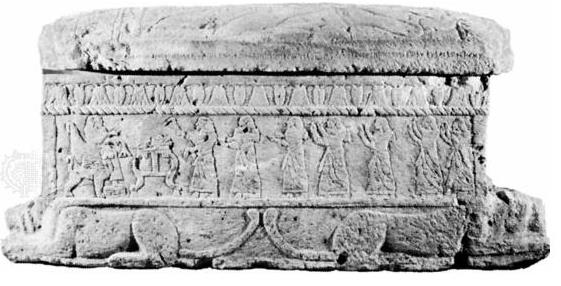Sarcophagus of Ahirom, 10th century BCE
Sarcophagus of Ahirom
This limestone sarcophagus for Ahirom/Ahiram, King of Byblos (a site on the Lebanese coast) is found in the Beirut Museum. An inscribed Phoenician inscription on the cover identifies the receptacle as a “Sarcophagus made by Ittobaal, son of Ahiram, king of Byblos, for Ahiram his father as a dwelling place for all eternity.” Ahiram likely ruled in the tenth century BCE, a contemporary of King Solomon. The deceased king sits on a throne decorated with cherubim – composite creatures with the body of a lion, wings of a bird, and the head of a human. This creature, which combines the regal bearing, strength and ferocity of a lion, with the ability to fly, and higher reasoning capabilities of humans, served both gods and kings including as a throne. In the depiction, the deceased king, holding a drooping lotus symbolizing his death, sits before a table arrayed with food while receiving dignitaries and offering-bearers.
The Ahiram Sarcophagus and the Bible
The God of Israel, like king Ahiram, sat on a cherub throne. 1 Kings 6-23-28 describes the throne that covered the ark in the Holy-of-Holies, the innermost room in the Jerusalem Temple. Two giant cherubs (10 cubits or 15’ high) made of olive wood and overlaid with gold formed a throne. Standing side-by-side, their inner wings met to create a seat and their outer wings extended to touch the far walls of the chamber. Elsewhere in the temple, cherubim adorned the carved wooden doors and wooden wall panels (1 Kgs 6-29, 32, 34). Before the construction of the temple in Jerusalem, while Israel traveled through the desert, golden cherubim with extended wings covered the ark (Exod 25-17-22; 37-6-9) as it was transported in the Tent of Meeting. Comparable to the temple, and some scholars suggest that the Tent of Meeting description mimics the Jerusalem Temple, cherubs adorned the inner curtains and veil that closed off the Holy-of-Holies (Exod 26-1, 31; 36-8, 35). In addition to their Temple roles, cherubs guarded the entrance to the Garden of Eden (Gen 3-24) and served to transport God (Ps 18-11 = 2 Sam 22-11).
For additional information read the Anchor Bible Dictionary entry for “Cherubim.”; E. Borowski, “Cherubim- God’s Throne?” BAR 21.4 (1995); V. Hurowitz, “Inside Solomon’s Temple” BR 10.2 (1994)
Elizabeth Bloch-Smith





1 Comment on "Sarcophagus of Ahirom, 10th century BCE"
Trackback | Comments RSS Feed
Inbound Links